Science is for everyone
From curious kid to wildlife conservation scientist, Dr Phoebe Meagher champions diversity in STEM careers, smashing stereotypes and saving wildlife.
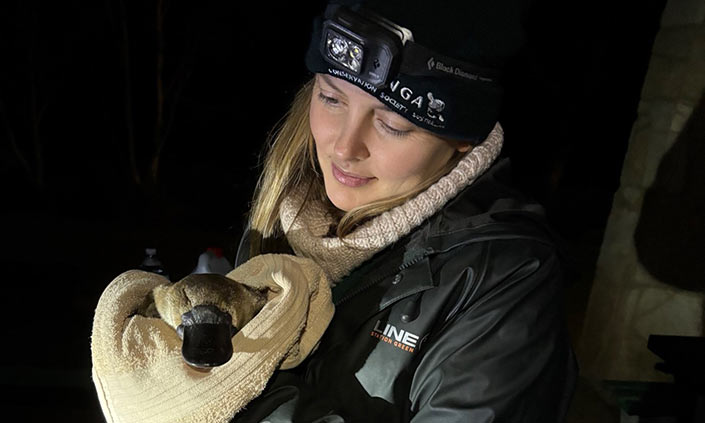
Dr Phoebe Meagher – who graduated from Macquarie University with a Bachelor of Environmental Science (Honours) in 2002 and is now a Wildlife Conservation Officer at Taronga Zoo – has always been curious about the natural world.
“As a young girl, I loved animals and being in nature. Some of my earliest memories are of holidays spent exploring the wild coastlines of South Australia and Kangaroo Island, returning a stranded baby dolphin to the water, collecting washed-up sea dragons and shark eggs after a storm, and trying to re-articulate skeletons of animals I found in the bush.
“I was curious about everything and it was all I ever remember wanting to do,” she says, but with only a few female biologists in books or the public eye, Dr Meagher didn’t know she could turn her interest into a career.
“Then, in the 90s, I remember watching Ranger Stacey on a show called Totally Wild – she was a really big influence.”
Suddenly, the young girl who had ‘pet’ blue-tongue lizards in her backyard, had plastered her bedroom walls with marine mammal posters, and even organised to free the bunnies at her pre-school, knew what she wanted to do.
“I truly believe you can’t be what you can’t see – that’s why it’s so important to promote diverse career pathways and jobs for women in traditionally male-dominated fields,” says Dr Meagher, who as part of the Superstars of STEM program and initiatives such as Women in Tech has actively worked to dismantle stereotypes in science by participating in events, educational outreach and mentoring programs designed to make scientific careers accessible to girls and diverse young people.
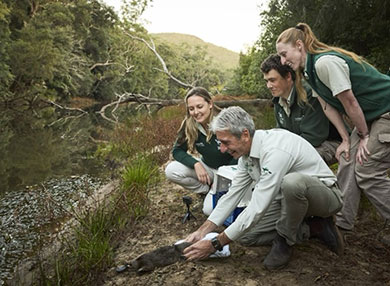 “Science is for everyone,” she affirms. “I always felt the push to squash some parts of me to fit a mould of someone working in a science lab, but I want to encourage girls to not shrink themselves or dim their light to make others in the room more comfortable.
“Science is for everyone,” she affirms. “I always felt the push to squash some parts of me to fit a mould of someone working in a science lab, but I want to encourage girls to not shrink themselves or dim their light to make others in the room more comfortable.
“Diversity is the key to solving the world’s global conservation problems,” she continues. “It takes a range of experience and backgrounds to look at old problems in a new way or with new knowledge and perspectives.”
And this is exactly what Dr Meagher has been doing, notably on her work adapting mining technology to help fight wildlife trafficking globally.
As she explains, “My interest in how forensic information can solve conservation problems was sparked while working at the Taronga Wildlife Hospital as a pathology assistant. My boss at the time, a veterinary pathologist, was noticing some unusual lesions (abnormal tissue) potentially caused by zoo-based diets.
“This led us to investigate differences in wild and zoo-based diets, which in turn, got me wondering if diet analysis could be used to determine where animals might have come from – one of the biggest issues in the illegal wildlife trade.”
About the same time, Dr Meagher heard a talk by the director of TRAFFIC Southeast Asia about the widespread trade in wildlife falsely labelled as captive-bred to exploit a legal loophole.
“The example he used was the illegal trafficking of echidnas,” says Dr Meagher. “I remember him musing, ‘If only there was a way to tell if an animal was captive-bred or wild-caught’. This made me think – could the research we were doing on echidna diets also be the answer to this question?’”
It was a great idea, but not a research priority – yet. “I believed it had great potential, so with support from the science director at the time, who was a huge inspiration as I was starting out at Taronga, I applied for some grants, and it has just grown from there. It’s a really exciting project that has taken me around the world to speak at COP19 and Interpol, and the data is now being used by state and federal authorities to build cases against the world’s biggest wildlife criminals.”
Very simply, in partnership with UNSW and UTS, Dr Meagher and her team at Taronga Zoo went on to test if the elements stored in animal keratin (hair, feathers, scales) could be unique to the location of where the animal is from, and found high levels of accuracy to determine origin in echidna, pangolin, cockatoo, freshwater turtles, blue-tongue lizards and shingleback lizards.
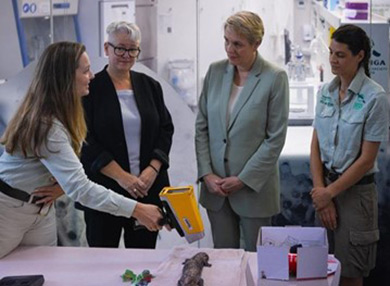 “Using a portable XRF Vanta (pXRF), which is non-invasive and about the size and shape of a hairdryer, we can determine provenance with high levels of accuracy in real time. This tech was traditionally used in the mining industry to measure geological elements, but with partners, the team has now custom-built biological models that will have a huge impact on wildlife science.”
“Using a portable XRF Vanta (pXRF), which is non-invasive and about the size and shape of a hairdryer, we can determine provenance with high levels of accuracy in real time. This tech was traditionally used in the mining industry to measure geological elements, but with partners, the team has now custom-built biological models that will have a huge impact on wildlife science.”
Last year, the tech was trialled alongside the Rapiscan RTT-110, an advanced 3D scanner co-developed by Taronga associate and fellow Macquarie alumni Dr Vanessa Pirotta (pictured) and the Rapiscan Systems team.
“Combining these two innovative tech solutions, we contributed to seizing, treating and re-homing over 100 animals and providing expert data to the prosecuting authorities,” says Dr Meagher.
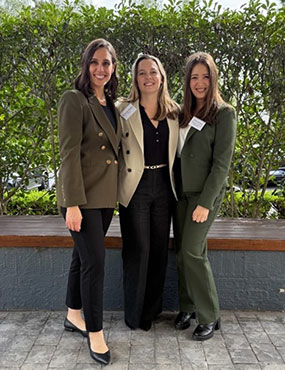 “Vanessa and I now work alongside another amazing Macquarie alumni, Zara Bending (also pictured), to tackle illegal wildlife trade on multi-disciplinary fronts using tech, science and the law.”
“Vanessa and I now work alongside another amazing Macquarie alumni, Zara Bending (also pictured), to tackle illegal wildlife trade on multi-disciplinary fronts using tech, science and the law.”
Dr Meagher may have graduated from Macquarie University in 2002, but its influence is enduring, and her connection remains strong. “A lot of my meaningful memories are from times spent with people I met at Macquarie, and many of those connections have led to job and research opportunities, as well as friendship.”
Drawn to Macquarie’s reputation as a leader in environmental and biological sciences, it was the hands-on opportunities – such as the mammal handling course and the field trip to Heron Island – that appealed. “They did not disappoint! It was these practical, out of the lecture hall experiences that confirmed I wanted to be working with wildlife in the field.”
She notes the supervising team for her honours thesis was encouraging, too. “They made sure I met the right contacts at DPI (Department of Primary Industries) Fisheries and had the right skillset to embark on a project that used conservation genetics to assess the diversity of grey nurse shark populations in Australia – it led to a lifetime of interest in both conservation and shark biology.”
As a Wildlife Conservation Officer at Taronga Zoo, being part of the forensics program is just one of the diverse projects Dr Meagher manages.
“I also spend my time in platypus and marine turtle conservation recovery, and we do all the population management for the zoo. I’m involved in education too, and still get to spend a lot of time in the field.”
But she emphasises working in the field isn’t the only place for wildlife conservationists.
“There are many pathways and many diverse jobs that are needed to help threatened wildlife. We need coders, communicators, technicians, keepers and project managers,” she says.
And there’s a whole cohort of women just waiting to step up. “I’m starting to see my peers in positions of power, being mentors and role modelling – and they’re smashing it. They’re helping the next generation of women up, they’re providing opportunities, they’re backing each other, and promoting their colleagues.
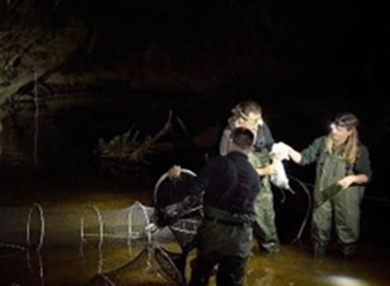 “I used to think you needed a science degree and passion to succeed in a wildlife science career, but I’ve come to learn it’s all about being curious, courageous, adventurous, and above all, determined. Determined to get the job, to tag the animal, to get the funding. Determined to make a difference.
“I used to think you needed a science degree and passion to succeed in a wildlife science career, but I’ve come to learn it’s all about being curious, courageous, adventurous, and above all, determined. Determined to get the job, to tag the animal, to get the funding. Determined to make a difference.
“Once you’re in the field and it’s 3am and 0 degrees, or you’re hauling a 100-kilogram turtle out of the water, it’s got nothing to do with your grades anymore, it’s purely about determination. Practical skills, grit and determination will get you where you want to be.”
Dr Meagher’s bio
Dr Phoebe Meagher holds a Bachelor of Environmental Science (Honours) from Macquarie University (2002). A lover of wildlife and wild places, she is based in Sydney and works at Taronga Conservation Society as a Wildlife Conservation Officer.
Dr Meagher also holds a PhD in Zoology from The University of Sydney. Both her honours and PhD theses focused on her favourite group of animals, elasmobranchs (sharks and rays). Throughout her studies, she worked as an aquarist at Oceanworld in Manly, and as a research assistant operating research vessels and undertaking subtidal marine research as part of the Ecological Impacts Centre research dive team.
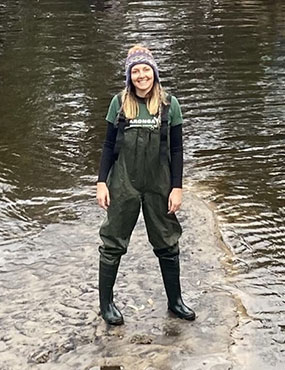 Between her honours year and PhD, Dr Meagher spent a year travelling South-East Asia and Europe, working as a dive master and deckhand on superyachts. Her practical marine experience has assisted her in the field, where she now leads conservation projects such as marine turtle tagging to explore habitat use in NSW and conservation recovery of platypus populations in freshwater ecosystems.
Between her honours year and PhD, Dr Meagher spent a year travelling South-East Asia and Europe, working as a dive master and deckhand on superyachts. Her practical marine experience has assisted her in the field, where she now leads conservation projects such as marine turtle tagging to explore habitat use in NSW and conservation recovery of platypus populations in freshwater ecosystems.
Dr Meagher also leads Taronga’s commitment to combating the illegal wildlife trade, building partnerships with academia and industry to tackle the ever-growing threat of wildlife trafficking. This project has seen her present at CITES CoP19 in Panama, Interpol and several leading wildlife crime summits.
She has also appeared in Harper’s Bazaar, Australian Geographic and National Geographic, as well as the ABC’s 7:30 and Catalyst. Dr Meagher is a passionate advocate for gender representation in wildlife science, using ambassador platforms such as the Superstars of STEM, Future You Path Finders and her role as global representative for Women in Wildlife to increase visibility of diverse pathways and careers in science.